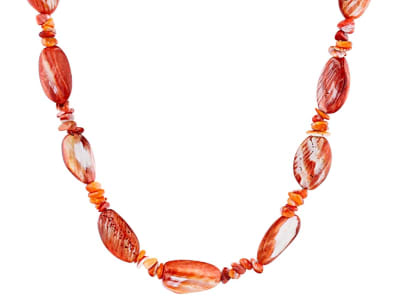Spiny oyster shells, also called thorny oyster, come from the genus Spindylus. They are not true oysters but are more closely related to scallops. Spiny oysters are found in all subtropical and tropical seas, but the varieties known to be used in jewelry come from Spondylus princeps and Spondylus calcifer found in the Pacific Ocean and Spondylus gaederopus found in the eastern Mediterranean Sea. Spiny Oyster shells have been found in Andean archaeological sites dating to 4200-2500 BCE. The Zuni silversmiths frequently used the shell in their mosaic jewelry and decorative arts.
General Information
null Colors
-
 Bi-color
Bi-color -
 Multi-color
Multi-color -
 Orange
Orange -
 Purple
Purple -
 Red
Red -
 White
White
Alternate Names
Spondylus, thorny oysters
Countries of Origin
Colombia; Ecuador; Nicaragua; El Salvador; Panama; United States of America; Guatemala; Mexico; Costa Rica
History
Spiny oyster shells were important trade goods in prehistoric North, Central and South American cultures as well as the early Neolithic European peoples. The shells were used in ritual and ceremonial objects, personal ornamentation, decorative objects, and architectural construction materials. The earliest known shell artifacts were found in Northern Peru and date to 4200-2500 BCE. It is thought that most of the shell material found in Central and South American archeological sites was sourced from the coast of Ecuador. It has been reported that the shell used in prehistoric tribal jewelry and artifacts in the American Southwest was sourced primarily from the Gulf of California, but the Gulf of Mexico and the Pacific Coast could have been sources as well. The eastern Mediterranean Sea was the source of spiny oyster shells for early European cultures.
Care
Soluble in hydrochloric acid. Shell is very soft, so be mindful of scratching. Avoid sudden temperature changes, chemicals, and ultrasonic cleaners. In addition to above precautions: avoid perfumes, and hairsprays.
More About null
Ancient Incas used the shells as offerings to their gods in exchange for rain and good harvests.
